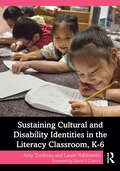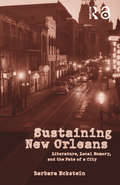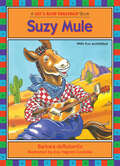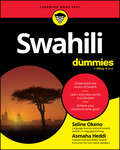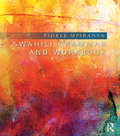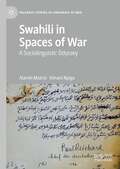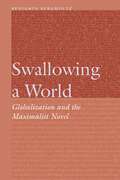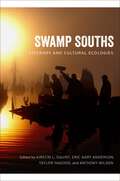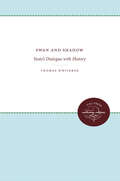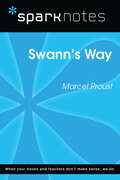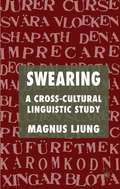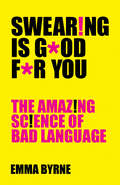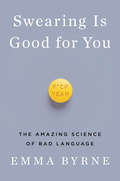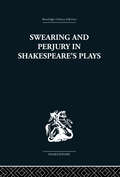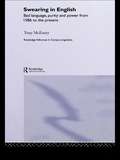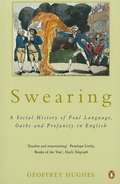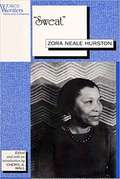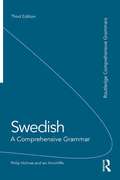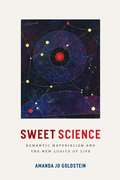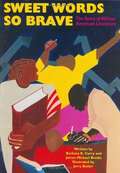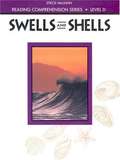- Table View
- List View
Sustaining Cultural and Disability Identities in the Literacy Classroom, K-6
by Amy Tondreau Laurie RabinowitzIdeal for literacy methods and elementary instruction courses, this book brings together three strands of educational practice—Culturally Sustaining Pedagogy (CSP), Disability Sustaining Pedagogy (DSP), and balanced literacy—to present a cohesive, comprehensive framework for literacy instruction that meets the needs of all learners. Situating balanced literacy instruction within the current debate on how to best teach elementary school literacy, this book prepares pre-service and in-service teachers to work with racially, ethnically, and linguistically diverse students of all abilities and disabilities and addresses effective curriculum design, lesson planning, and assessment. Chapters offer real-world classroom examples and lesson plans, charts, and discussion guides for CSP/DSP-infused instruction for each component of a balanced literacy instructional block.
Sustaining New Orleans: Literature, Local Memory, and the Fate of a City
by Barbara EcksteinFirst published in 2006. Routledge is an imprint of Taylor & Francis, an informa company.
Sutpen's Design: Interpreting Faulkner's Absalom, Absalom!
by Dirk Kuyk Jr.From the prologue: "This book began in an undergraduate class on William Faulkner's Absalom, Absalom! Because the students kept referring to "Sutpen's design" without pausing to define it, I asked, "What, exactly, was Sutpen trying to do?" They gave the answers that I expected. They had, after all, read not only the novel but also some of the criticism; and they had accepted, as I had, the basic account that has been developed since Absalom was published in 1936. When I asked for evidence to back up their answers, the students pointed to passages that every critic would cite. Ordinarily, I would have accepted the citations; this time, to make the students defend their interpretations, I set out to challenge them-and discovered that the passages fail to support the interpretations. When they collapsed, my interpretation also collapsed; it stood on the same ground. So did all the criticism that I had read; it would also fall. Now, after surveying virtually all the criticism of Absalom, I have concluded that the account that forms the basis for that criticism is mistaken. This book argues that the account is flawed in two crucial ways. It misunderstands both what Sutpen is trying to do and how the narration works. As a result of the first misunderstanding the account fails to explain, for example, why Sutpen rejects Bon and what Sutpen hoped for in striving to complete his design. The second misunderstanding has led critics to see Absa lom as a web of hypothetical narratives that cannot be verified. Because the book's characters serve as narrators and are patently unreliable, critics have doubted that a trustworthy narrative can be derived from what we are given. I believe that the book's narrative technique reveals a way to authenticate the narrative. These ideas about Sutpen's design and about the narration lead to a detailed reinterpretation of Absalom."
Suzy Mule: Long Vowel U (Let's Read Together ®)
by Barbara deRubertisLet&’s Read Together books merge rhyme and vowel sounds in delightfully zany stories kids will want to read again and again. Each of the 15 books in this classic series by award-winning author/educator Barbara deRubertis will give your child a jumpstart on reading success."Story lines are silly and inventive, and recall Dr. Seuss&’s Cat in the Hat for the building of rhythm and rhyming words." —School Library JournalSuzy Mule has the flu and is feeling blue. Then she gets a super idea: go south! (This easy-to-read story features the long &“u&” vowel sound.)
Swahili For Dummies
by Seline Okeno Asmaha HeddiLearn the official language of Kenya and Tanzania Swahili For Dummies will teach you the basics of Swahili, so you can start conversing in Africa’s language of commerce. This book introduces you to the foundations of Swahili grammar and enables you to engage in basic conversations. With the simplified Dummies learning process, you’ll quickly get a grasp on the language, without complex terms and confusing explanations. You’ll also move through the book at a comfortable pace, so you’ll be familiar with what you’ve learned before moving on to more complex stuff. Focus on communication and interaction in everyday situations, so you can actually use the language you’re studying—right away. Understand the basics of Swahili Learn everyday words and phrases Gain the confidence to engage in conversations in Swahili Communicate while traveling and talk to Swahili-speaking family members Swahili For Dummies is for readers of all ages who want to learn the basics of Swahili in a no-stress, beginner-friendly way. Swahili teachers will also love sharing this practical approach with their students.
Swahili Grammar and Workbook
by Fidèle MpiranyaSwahili Grammar and Workbook provides a practical and comprehensive companion to Swahili grammar, filling in gaps left by other textbooks. Presenting the essentials of Swahili grammar in a highly accessible fashion, it reduces complex language topics to helpful rules and mnemonic aids, enabling maximum grammar retention and accurate usage. Grammar points are followed by multiple examples and exercises, allowing students to consolidate and practice their learning. No prior knowledge of linguistic terminology is required. Key features include: Twenty five language notes covering key topics such as: personal pronouns; the Swahili noun class system; special class combinations; the imperative, the subjunctive, and the conditional moods; the use of comparatives; the use of monosyllabic verbs; the passive form and various other forms of verb extensions; the relative clause Clear, detailed and jargon-free grammatical explanations supported by an assortment of helpful diagrams, charts and tables and many relevant and up-to-date examples A wide range of communication-oriented exercises to reinforce learning and develop students’ ability to use Swahili actively Audio files to support pronunciation practice, clearly linked to relevant sections of the book and available for free download at http://www.routledge.com/books/details/9781138808263/ Four appendices, Swahili-English and English-Swahili vocabulary lists, a bibliography and an index presented at the back of the book for easy access to information. Written by a highly experienced instructor, Swahili Grammar and Workbook will be an essential resource for all students and teachers of Swahili. It is suitable for use both as a companion reference text in language courses and as a standalone text in independent grammar classes.
Swahili in Spaces of War: A Sociolinguistic Odyssey (Palgrave Studies in Languages at War)
by Kimani Njogu Alamin MazruiThis monograph examines the roles and functions of Swahili in war/conflict situations, and the impact of wars on the destiny of the language. Covering a period of over a century, the monograph explores this sociolinguistic theme in the context of six wars/conflicts: the Maji Maji resistance against German rule, the two World Wars, the anti-colonial resistance to British colonialism, the wars of the Great Lakes region, the cold wars, and the ongoing war against terrorism. In geographical focus, some of the war situations explored here are “local,” others are “transnational,” and others still rather “global” in scope and ramifications. In the final analysis, the monograph provides important snapshots of the conflict-based history of the Swahili language, demonstrating once again that language is a malleable tool that can be appropriated and galvanized to serve the interests of either party in a conflict and sometimes as a means of creating hegemonic and anti-hegemonic meanings.
Swallowing a World: Globalization and the Maximalist Novel (Frontiers of Narrative)
by Benjamin BergholtzSwallowing a World offers a new theorization of the maximalist novel. Though it&’s typically cast as a (white, male) genre of U.S. fiction, maximalism, Benjamin Bergholtz argues, is an aesthetic response to globalization and a global phenomenon in its own right. Bergholtz considers a selection of massive and meandering novels that crisscross from London and Lusaka to Kingston, Kabul, and Kashmir and that represent, formally reproduce, and ultimately invite reflection on the effects of globalization. Each chapter takes up a maximalist novel that simultaneously maps and formally mimics a cornerstone of globalization, such as the postcolonial culture industry (Salman Rushdie&’s Midnight&’s Children), the rebirth of fundamentalism (Zadie Smith&’s White Teeth), the transnational commodification of violence (Marlon James&’s A Brief History of Seven Killings), the obstruction of knowledge by narrative (Zia Haider Rahman&’s In the Light of What We Know), and globalization&’s gendered, asymmetrical growth (Namwali Serpell&’s The Old Drift). By reframing analysis of maximalism around globalization, Swallowing a World not only reimagines one of the most perplexing genres of the late twentieth and early twenty-first centuries but also sheds light on some of the most perplexing political problems of our precarious present.
Swamp Souths: Literary and Cultural Ecologies
by Rebecca Mark Keely Byars-Nichols Susan Thananopavarn Scott Romine Zackary Vernon William Tynes Cowan Rain Prud'Homme-Cranford Josh-Wade Ferguson Hannah Godwin Peter Jay Ingrao Joseph Kuhn Lauren E. LaFauci John Wharton Lowe Jessica Martell Matthew E. Suazo Matthew Sutton Mitch TherieauSwamp Souths: Literary and Cultural Ecologies expands the geographical scope of scholarship about southern swamps. Although the physical environments that form its central subjects are scattered throughout the southeastern United States—the Atchafalaya, the Okefenokee, the Mississippi River delta, the Everglades, and the Great Dismal Swamp—this evocative collection challenges fixed notions of place and foregrounds the ways in which ecosystems shape cultures and creations on both local and global scales. Across seventeen scholarly essays, along with a critical introduction and afterword, Swamp Souths introduces new frameworks for thinking about swamps in the South and beyond, with an emphasis on subjects including Indigenous studies, ecocriticism, intersectional feminism, and the tropical sublime. The volume analyzes canonical writers such as William Faulkner, Zora Neale Hurston, and Eudora Welty, but it also investigates contemporary literary works by Randall Kenan and Karen Russell, the films Beasts of the Southern Wild and My Louisiana Love, and music ranging from swamp rock and zydeco to Beyoncé’s visual album Lemonade. Navigating a complex assemblage of places and ecosystems, the contributors argue with passion and critical rigor for considering anew the literary and cultural work that swamps do. This dynamic collection of scholarship proves that swampy approaches to southern spaces possess increased relevance in an era of climate change and political crisis.
Swan Dive
by Brenda HasiukA teenage refugee adapts to a new country, a new language, new school and even finds a wonderful best friend, until the pressures of past and present collide and lead to a lie that changes everything. Refugees from the Bosnian War, Lazar’s family flees the Siege of Sarajevo and arrives in Winnipeg in the early 1990s. Despite various mini dramas unfolding at home, as his parents and older sisters navigate a new language, the bitter cold and a strange city and country, Lazar manages to find a place for himself at school, largely by making friends with Elle, a sassy, outspoken girl who divides her time between living with her hoarder mother (who stuffs their tiny apartment with bargains she finds at Liquidation World) and her hippie father, Jimmy, who lives in British Columbia. But as two geeky loners, Elle and Lazar are happy in their own bubble of friendship, especially after they form a pop duo and dream of making it big on Star Search. Soon Lazar’s desperate escape out of Sarajevo seems far away, even as the trauma of his broken homeland looms large with his family at home. Then Elle comes back from Vancouver after a summer at Jimmy’s, and things are different. They’re in high school, Elle has lost weight and blossomed into popularity, while Lazar remains small, skinny and forgettable. She seems to have forgotten all about their singing plans and starts spending time with a new kid, Ivan. Lazar is unmoored and filled with new longings — for Elle, for Ivan, for a sense that he belongs somewhere. His mother and older sisters worry about his health, that he’s so thin, that he’s not interested in sports, even though the doctors can’t find anything wrong. And then, in an impulsive moment, Lazar tells Ivan that he’s seriously ill. And with this one reckless lie he suddenly gets — and loses — everything he thought he wanted. Key Text Features author’s note historical context Correlates to the Common Core State Standards in English Language Arts: CCSS.ELA-LITERACY.RL.6.6 Explain how an author develops the point of view of the narrator or speaker in a text.
Swan and Shadow: Yeats's Dialogue with History
by Thomas WhitakerHistory was central in a variety of ways to Yeats's poetic development and to the meaning of his work. In this study, Whitaker suggests that history was for the poet a mysterious interlocutor, which Yeats saw at times as a bright reflection of himself and again as a dark force opposed to that self. The poet's internal dialogue is viewed as projection into historical symbolism.Originally published in 1964.A UNC Press Enduring Edition -- UNC Press Enduring Editions use the latest in digital technology to make available again books from our distinguished backlist that were previously out of print. These editions are published unaltered from the original, and are presented in affordable paperback formats, bringing readers both historical and cultural value.
Swann's Way (SparkNotes Literature Guide Series)
by SparkNotesSwann's Way (SparkNotes Literature Guide) by Marcel Proust Making the reading experience fun! Created by Harvard students for students everywhere, SparkNotes is a new breed of study guide: smarter, better, faster. Geared to what today's students need to know, SparkNotes provides: *Chapter-by-chapter analysis *Explanations of key themes, motifs, and symbols *A review quiz and essay topicsLively and accessible, these guides are perfect for late-night studying and writing papers
Swearing
by Magnus LjungThis study provides a definition and a typology of swearing and compares its manifestations in English and 24 other languages. In addition the study traces the history of swearing from its first known appearance in Ancient Egypt to the present day.
Swearing Is Good For You: The Amazing Science of Bad Language
by Dr. Emma ByrneIn the vein of The Man Who Mistook His Wife for a Hat comes a fascinating and fun look at the new science of bad language.Did you know that chimpanzees can swear? Or that we do most of our swearing in our first language? Have you ever noticed that swearing is an excellent painkiller? In delightfully fun and accessible language, backed by riveting historical case studies and the latest cutting-edge research, Dr. Emma Byrne explores the science behind swearing and why bad language might actually be good for us. Swearing, it turns out, is socially and emotionally essential. Not only has some form of swearing been around since the earliest humans began to communicate, but it has been shown to reduce physical pain, prevent violence, help stroke victims recover their language, and help people work together as a team. Swearing Is Good For You is a fascinating and fun look at the new science of bad language.
Swearing Is Good for You: The Amazing Science Of Bad Language
by Emma ByrneAn irreverent and impeccably researched defense of our dirtiest words. We’re often told that swearing is outrageous or even offensive, that it’s a sign of a stunted vocabulary or a limited intellect. Dictionaries have traditionally omitted it and parents forbid it. But the latest research by neuroscientists, psychologists, sociologists, and others has revealed that swear words, curses, and oaths—when used judiciously—can have surprising benefits. In this sparkling debut work of popular science, Emma Byrne examines the latest research to show how swearing can be good for you. With humor and colorful language, she explores every angle of swearing—why we do it, how we do it, and what it tells us about ourselves. Not only has some form of swearing existed since the earliest humans began to communicate, but it has been shown to reduce physical pain, to lower anxiety, to prevent physical violence, to help trauma victims recover language, and to promote human cooperation. Taking readers on a whirlwind tour through scientific experiments, historical case studies, and cutting-edge research on language in both humans and other primates, Byrne defends cursing and demonstrates how much it can reveal about different cultures, their taboos and their values. Packed with the results of unlikely and often hilarious scientific studies—from the “ice-bucket test” for coping with pain, to the connection between Tourette’s and swearing, to a chimpanzee that curses at her handler in sign language—Swearing Is Good for You presents a lighthearted but convincing case for the foulmouthed.
Swearing and Perjury in Shakespeare's Plays (Routledge Library Editions Shakespeare #XXXIII)
by Frances A ShirleyFirst published in 1979. How do the elements of swearing and perjury work in Shakespeare's plays? What effect did Shakespeare intend when he wrote them? How did they contribute to the delineation of character? These questions are investigated by combining a history of ideas approach with close textual analysis. The book begins by bringing together material from a wide range of contemporary sources in order to create a sense of popular awareness of oaths in Queen Elizabeth's time. Out of this emerges a scale of the relative strength of various oaths, an awareness of the ways in which people regarded perjury, and an appreciation of the attempts to prohibit profanity. Shakespeare's work is then examined against this background.
Swearing in English: Bad Language, Purity and Power from 1586 to the Present (Routledge Advances in Corpus Linguistics #Vol. 1)
by Tony McEneryDo men use bad language more than women? How do social class and the use of bad language interact? Do young speakers use bad language more frequently than older speakers? Using the spoken section of the British National Corpus, Swearing in English explores questions such as these and considers at length the historical origins of modern attitudes to bad language. Drawing on a variety of methodologies including historical research and corpus linguistics, and a range of data such as corpora, dramatic texts, early modern newsbooks and television, Tony McEnery takes a socio-historical approach to discourses about bad language in English. Arguing that purity of speech and power have come to be connected via a series of moral panics about bad language, the book contends that these moral panics, over time, have generated the differences observable in bad language usage in present day English. A fascinating, comprehensive insight into an increasingly popular area, this book provides an explanation, and not simply a description, of how modern attitudes to bad language have come about.
Swearing: A Social History of Foul Language, Oaths and Profanity in English
by Geoffrey HughesTracing the history of swearing from ancient Anglo-Saxon traditions and those of the Middle Ages, through Shakespeare, the Enlightenment and the Victorians, to the Lady Chatterley trial and various current trends, Geoffrey Hughes explores a fascinating, little discussed yet irrespressible part of our linguistic heritage. This second edition contains a Postscript updating various contemporary developments, such as the growth of Political Correctness.
Sweat
by Zora Neale Hurston Cheryl A. WallNow frequently anthologized, Zora Neale Hurston's short story "Sweat" was first published in Firell, a legendary literary magazine of the Harlem Renaissance, whose sole issue appeared in November 1926. Among contributions by Gwendolyn Bennett, Countee Cullen, Langston Hughes, and Wallace Thurman, "Sweat" stood out both for its artistic accomplishment and its exploration of rural Southern black life. In "Sweat" Hurston claimed the voice that animates her mature fiction, notably the 1937 novel Their Eyes Were Watching God; the themes of marital conflict and the development of spiritual consciousness were introduced as well. "Sweat" exemplifies Hurston's lifelong concern with women's relation to language and the literary possibilities of black vernacular. <p><p> This casebook for the story includes an introduction by the editor, a chronology of the author's life, the authoritative text of "Sweat," and a second story, "The Gilded Six-Bits." Published in 1932, this second story was written after Hurston had spent years conducting fieldwork in the Southern United States. The volume also includes Hurston's groundbreaking 1934 essay, "Characteristics of Negro Expression," and excerpts from her autobiography, Dust Tracks on a Road. An article by folklorist Roger Abrahams provides additional cultural contexts for the story, as do selected blues and spirituals. Critical commentary comes from Alice Walker, who led the recovery of Hurston's work in the 1970s, Robert Hemenway, Henry Louis Gates, Gayl Jones, John Lowe, Kathryn Seidel, and Mary Helen Washington.
Swedish: An Essential Grammar (Routledge Comprehensive Grammars)
by Philip Holmes Ian HinchliffeWinner of the Swedish National Language Council’s Erik Wellander Prize, 2003 Swedish: A Comprehensive Grammar is an award-winning complete reference guide to modern Swedish grammar. Systematic and accessible, the volume is organised to promote a thorough understanding of Swedish grammar, presenting the complexities of Swedish in a concise and readable form. Explanations are full, clear and free of jargon, and an extensive index, numbered paragraphs, cross-references and summary charts provide readers with easy access to the information they require. Now in its third edition, the text has been comprehensively updated to conform to new standards set in the description of language and to reflect the recommendations of the Language Council of Sweden. It offers an improved layout, completely revised index and more user-friendly paragraph structure. Continuing the tradition of previous editions, the emphasis remains fixed on Swedish in everyday communication, drawing on modern corpus material, the internet and the media to provide high frequency words and expressions. Examples have been modernised throughout and new content takes account of recent trends resulting from the increasing democratisation of written Swedish. Features include: detailed treatment of grammatical structures and parts of speech a wealth of examples from present-day Swedish particular attention to areas of confusion and difficulty for learners Swedish/English contrasts highlighted throughout the book chapters on word formation, orthography and punctuation. Swedish: A Comprehensive Grammar is the most thorough and detailed Swedish grammar available in English and is an essential reference source for the learner and user of Swedish, irrespective of level. It is ideal for use in schools, colleges, universities and adult classes of all types.
Sweet Science: Romantic Materialism and the New Logics of Life
by Amanda Jo GoldsteinToday we do not expect poems to carry scientifically valid information. But it was not always so. In Sweet Science, Amanda Jo Goldstein returns to the beginnings of the division of labor between literature and science to recover a tradition of Romantic life writing for which poetry was a privileged technique of empirical inquiry. Goldstein puts apparently literary projects, such as William Blake’s poetry of embryogenesis, Goethe’s journals On Morphology, and Percy Shelley’s “poetry of life,” back into conversation with the openly poetic life sciences of Erasmus Darwin, J. G. Herder, Jean-Baptiste Lamarck, and Étienne Geoffroy Saint-Hilaire. Such poetic sciences, Goldstein argues, share in reviving Lucretius’s De rerum natura to advance a view of biological life as neither self-organized nor autonomous, but rather dependent on the collaborative and symbolic processes that give it viable and recognizable form. They summon De rerum natura for a logic of life resistant to the vitalist stress on self-authorizing power and to make a monumental case for poetry’s role in the perception and communication of empirical realities. The first dedicated study of this mortal and materialist dimension of Romantic biopoetics, Sweet Science opens a through-line between Enlightenment materialisms of nature and Marx’s coming historical materialism.
Sweet Words So Brave: The Story of African American Literature
by Barbara K. Curry James M. BrodieA survey of the history of African American literature, from slave narratives to the present, told in the voice of a grandfather speaking to his granddaughter.
Swells and Shells: Reading Comprehension Level D
by Steck-Vaughn StaffRead an exciting story while learning more about good reading comprehension.
Swift (Routledge Revivals)
by W. A. SpeckFirst published in 1969, this title examines the works of Jonathan Swift from both a literary and an historical perspective. W. A. Speck first presents Swift in his historical context, analysing in particular the interplay between his religious and political views. Light is thrown on the early pamphlets as well as on A Tale of a Tub and Gulliver’s Travels, alongside a fascinating chapter by Philip Roberts considering Swift’s poetry. This illuminating title will be of value to any literature students with an interest in the writings of Swift and the historical context in which he worked.
Swift and History
by Ashley MarshallSwift has been said to have little interest in history; his attempts to write it have been disparaged and his desire to become Historiographer Royal ridiculed. Ashley Marshall argues that history mattered enormously to Swift. He read a vast amount of history and uses historical examples copiously in his own works. This study traces Swift's classical and modern historiographical inheritance; analyses his unsuccessful attempt to write a history of England; and offers radical re-reading of his History of the Four Last Years of the Queen. A systematic analysis of Swift's view of 'authority' is highly revealing. His attitudes toward power and authority, sovereigns' and subjects' rights, parliamentary representation, and succession are reflected in his lifelong engagement with and pervasive use of the past. Studying Swift and history enables a deeper understanding of his authoritarian and historiographically Tory outlook - and how it changed when Swift's party fell from power in 1714.
